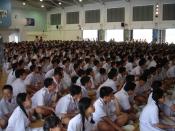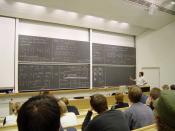Lights, camera, action! A significant morning in the life of a potential college student unfolds like the scenes of a movie, portraying the teenager's chaotic actions. Brushing his teeth, he glares at his SAT vocabulary list and memorizes ten terms with his exhausted cerebrum. Chugging and crunching his breakfast cereal, he stares at the marshmallows in the milk and imagines them as miniature math symbols, hissing and grunting, ready to smack his brain if he forgets the equations of polynomial functions. Driving his car, he glances at the notes attached to his windshield and reviews the strategies for success on critical reading questions. Finally, the teenager enters the testing site and finds himself facing one of the most vital challenges of his life - the SAT. Despite the negative effects of excessive studying, this student gains knowledge and skills critical not only for success in college, but also life in general.
In addition, colleges benefit through acknowledging the applicant's abilities, which the SAT adequately measures. Furthermore, students and colleges also gain other advantages through the assessment. Therefore, the SAT should be a necessary factor for college entrance because it offers benefits to both the students and colleges.
Over the years, numerous students, parents and educators have lobbied against the SAT, arguing that it does not provide a reasonable indicator of the applicants' abilities and knowledge used for college admission. Some declare that the test, intending to aid colleges in selecting diverse students of different backgrounds, favors the rich and elite. This, they suggest, distorts the college's ability to select teenagers capable of achieving excellence in their future school years. Many even criticize that experts can easily coach the SAT; hence, the score of the assessment fails in indicating an accurate measure of potential performance and skills acquired by the student.


